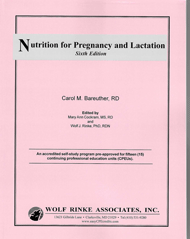|
This up-to-date comprehensive activity will enable
you to:
- utilize a five part nutritional assessment process
- plan effective nutritional intervention strategies
- recognize the physiological changes in pregnancy and how they affect
nutritional
- needs and feeding strategies
- identify how alcohol, artificial sweeteners, caffeine, contaminants,
nicotine and drugs affect nutritional intake and maternal-fetal health
during pregnancy and lactation
- relate how exercise influences prenatal nutritional needs and postnatal
lactation
- define gestational diabetes and pregnancy-induced hypertension,
and identify nutritional intervention in these disorders
- learn about special needs of teens, multifetal pregnancies, vegetarians
and mothers who have diabetes, hypertension, allergies and HIV
- formulate safe and effective nutrition intervention for weight
reduction postpartum, for lactating and non-lactating women
Share with a friend and Save! Click here for important information about
sharing.
To order an ADDITIONAL Reporting Form click below:
| T352F |
15 CPEUs |
REPORTING FORM |
Currently out of stock.
New inventory coming soon. |
|
© 2024 Wolf Rinke Associates. All rights reserved for this self-directed accredited learning activity. Reproduction in whole or part without written permission, except for brief excerpts, is prohibited.
OBJECTIVES
Upon completion of this accredited, self-directed CPE program, you should be able to:
- Recognize the link between past and present nutritional status, and its effect on conception, maternal health, fetal growth and a successful birth outcome.
- Identify nutritional, non-nutritional and lifestyle factors that affect fertility.
- Describe the relationship and importance of preconceptional and prenatal folic acid supplementation to the prevention of neural tube defects in infants.
- Specify two key teaching frameworks for preconceptional, prenatal and postnatal nutrition counseling.
- Recognize the five parts of the nutritional assessment process and understand their usefulness in planning nutritional intervention preconceptionally, prenatally, and postnatally.
- Calculate BMI and relate this figure to recommended weight gain during gestation for single, twin and multifetal pregnancies.
- Plot prenatal weight gain and assess the adequacy of the rate and total amount of weight gain.
- Identify anemia in pregnancy, its definition, evaluation and dietary intervention.
- Define the physiological changes that occur in pregnancy and lactation.
- Interpret the nutritional needs of pregnancy and lactation as defined by the RDA into meal plans.
- Relate the nutritional needs of pregnancy to a vegetarian eating style.
- Define the nutritional, emotional and educational needs of pregnant teens.
- Identify food assistance programs that can benefit pregnant and lactating women.
- List situations when a vitamin-mineral supplement may be appropriate preconceptionally, prenatally and postnatally.
- Recognize how alcohol, artificial sweeteners, caffeine, contaminants, nicotine and drugs affect nutritional intake and maternal-fetal health during pregnancy and lactation.
- Relate how exercise influences prenatal nutritional needs and postnatal lactation success.
- Define gestational diabetes and pregnancy-induced hypertension, and identify nutritional intervention in these disorders.
- Specify breastfeeding benefits for both mother and infant.
- Identify nutrient needs during lactation and ways women can consume them in regular and vegetarian meal plans.
- Recognize the issues surrounding infant allergy and mother's diet in lactation.
- Specify current policy regarding breastfeeding and HIV-1 infection.
- Formulate safe and effective nutrition intervention for weight reduction postpartum, for lactating and nonlactating women.
ABOUT THE AUTHOR
Carol M. Bareuther is a Registered Dietitian and member of the Women’s Health Dietetic Practice Group. A New Jersey native, she holds a Bachelor of Science degree in Dietetics from Marshall University, Huntington, WV, and completed a dietetic internship at the University of Kentucky Medical Center, Lexington, KY. She completed post-graduate training in nutrition at the University of Kentucky and Drexel University in Philadelphia, PA.
Bareuther started her career as a pediatric-obstetric dietitian at the University of Kentucky Medical Center. Subsequently, she worked as a clinical dietitian at the Hospital University of Pennsylvania, Philadelphia, PA; as a therapeutic dietitian at the Roy L. Schneider Community Hospital, St. Thomas, U.S. Virgin Islands; and currently as a nutritionist for the Virgin Islands Special Supplementary Nutrition Program for Women, Infants and Children (WIC). She has authored American Dietetic Association-approved, self-directed, accredited CPE programs, Nutrition for Infants and Children, and Nutrition Therapy for Children with Attention Deficit Hyperactivity Disorder, published by Wolf Rinke Associates.
Bareuther works part-time as a freelance writer and has contributed food and nutrition articles to national publications such as Cooking Light, Vegetarian Gourmet, Deli Business, Produce Business, Food Distribution Magazine, Veggie Life, HeartCorps, Cruising World, Best Recipes, Vegetarian Journal, Fancy Food, Chefs, Caribbean Travel & Life, Latitudes South, and Pillsbury’s Fast and Healthy Magazine. From 1995 to 1999, Bareuther was the syndicated columnist for Copley News Services’ Kitchen Kids.
An author as well as a journalist, Carol has published two books, Virgin Islands Cooking and Sports Fishing in the Virgin Islands. She has co-authored Slim-To-Shore with Jan Robinson and Native Recipes, produced by the University of the Virgin Islands Cooperative Extension Service.
Since 1996 she has co-hosted “Nutrition in Good Taste,” a weekday radio nutrition program on WVWI AM 1000, which airs throughout the eastern Caribbean. Since 2000, Bareuther has co-hosted “Shape Up Virgin Islands,” a monthly half-hour PBS TV program that seeks to show culturally relevant ways to prepare healthful foods and incorporate physical activity.
Carol is the mother of two children and, in her spare time, enjoys cooking with her children, swimming, hiking, and reading.
Return to the top of page
If you prefer to order by phone, mail
or fax click below
or click here to contact us with
other questions.
For information about our other products and
services return to the sidebar at the top of the page.
|
|
|

